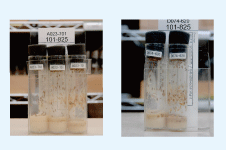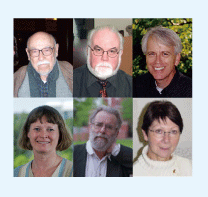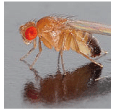|
 |
■ Bioresources information is available at the following URLs
|
 |
|
Introduction to Resource Center 〈No.34〉 Ten-year history of the Drosophila Genetic Resource Center - II -
- Future 10 years from the perspective of the past 10 years -
Masa-Toshi Yamamoto (Director, Drosophila Genetic Resource Center, Kyoto Institute of Technology)
A retrospective assessment of the last 10 years
The Drosophila Genetic Resource Center (DGRC) was established at the Kyoto Institute of Technology (KIT) by a ministerial order of the Ministry of Education (currently the Ministry of Education, Culture, Sports, Science and Technology) 10 years ago, and this event is still regarded with some curiosity. Indeed, Drosophila itself is not associated with craftwork or fabrics and thus does not match the image of KIT (in Japanese, the university is referred to as the Kyoto University of Industrial Arts and Textile Fibers). In spite of this situation, the research center has been maintaining this “unfit” species and is the world’s largest Drosophila preservation facility, breeding approximately 15 million Drosophila. These facts further amplify the curiosity associated with this facility. |
As of July 2010, a total of 26,000 strains are being maintained at DGRC. One set of Drosophila strains is maintained in 3 breeding bottles per strain and another set in 2 bottles per strain. In this manner, the 2 sets of Drosophila strains are being preserved in 2 isolated breeding rooms to avoid the possibility of simultaneous losses caused by fire or an earthquake and with the consideration of safety as the first priority. Each bottle contains approximately 100 adult Drosophila; thus, the center has 26,000 strains × 5 bottles/strain × 100 flies/bottle = - 13 million flies in total. We have also been maintaining an additional 2 million or more flies for research purposes at the center. Most of these Drosophila strains are pure lines and are genetically well-conserved, mutant Drosophila strains for research use. In addition, strains that are more important are doubly maintained at DGRC and a Drosophila strain center in the US (Photo 1). |

Photo 1: Breeding of Drosophila
Breeding in 3 bottles (left) |
The resource center originated from my laboratory and a breeding room in the Genetics Laboratory (which was subsequently renamed Chromosome Engineering Laboratory), Department of Applied Biology, Faculty of Textile Science, KIT. Before the establishment of my laboratory, Prof.. Takao Watanabe had proposed to develop a laboratory consisting of only Drosophila researchers if he would have to move out of the National Institute of Genetics. At that time, except for the laboratory in Tokyo Metropolitan University, none of the other laboratories consisted of only Drosophila researchers. |

Drosophila Genetic Resource Center (DGRC), Center Building |
Therefore, in 1993, we started working in collaboration to realize our common goal of establishing such a laboratory at KIT. I had heard that KIT had been primarily researching silkworms and aiming to develop more improved strains by breeding as well as by genetic engineering and recombination technology. KIT had been aiming to facilitate advanced research, including improvement of silkworm breeding by using Drosophila, a representative organism employed in genetic engineering technology. Therefore, I usually narrate this story to explain the reason for the foundation of DGRC at KIT. Although it is not clear whether KIT had such articulate reasons while recruiting researchers at each laboratory, this is the background of DGRC and the beginning of the development of a Drosophila laboratory at KIT. |
One year later, I had to make a budget request, which was a completely novel experience for me at that time. DGRC was then founded as a result of my encounters and interactions with the best people that I could imagine, although I will skip the background of how I met them. It was a truly difficult task, one that I will never be able to repeat. However, I remember that I felt an eagerness bordering on tenacity to found the resource center by any means possible.
I had no time to conduct any research, but I managed to prepare applications for the organization of the center (recruitment of professors, associate professors, research associates (transfers), part-time researchers, and research assistants), the administration cost, the construction plan of the center building and special facilities, the recruitment of foreign researchers (3 types of visiting researchers), and the subsequent sectional budget and associated cost. I regret that I troubled many students and my colleagues when I had no one else to rely on for the foundation of the center(Photo 2). |

Photo 2:Some documents prepared for the budget request |
International scenario at the time of the budget request |
Before 1990, several research institutions received a small budgetary allocation for covering the costs incurred in maintaining strains. In the case of Drosophila, this allocation was made to the National Institute of Genetics, Osaka University, and Nagasaki University, while the Tokyo Metropolitan University was funded by the Tokyo metropolitan government, a practice that has continued to date.
These institutions had operated Drosophila stock centers of some sort; however, these centers were small in scale. At that time, there were Drosophila strain stock centers at the California Institute of Technology and the Bowling Green State University in the US and at the Umeå University in Sweden in Europe, which was developed from a private laboratory, and these institutions had functioned as support bases for international Drosophila research. The stock center in the US was then moved to Indiana University with the transfer of Dr. Thom Kaufman. Around that time, Drosophila research gained prominence because of the studies on homeobox, which is a fundamental element of embryogenesis, and the importance of Drosophila was widely acknowledged as a result of these studies. In addition, rapid development in genome research and a large amount of published research results that employed transposable elements (P elements) as vectors for transformation facilitated the re-acknowledgement of the importance of strain centers. |

Photo3:Drs. Mel Green, Thom Kaufman, and Chuck Langley from the US (from the top left), Dr. Asa Rasmuson-Lestander from Sweden, Dr. Michael Ashburner from the UK, and Dr. Marie-Louise Cariou from France (from the bottom left). |
At that time, we had been considering the idea of requesting the Ministry of Education to found DGRC. Universities in the US and Europe were also aspiring to establish and expand Drosophila strain preservation facilities. For example, the Drosophila strain center at the Indiana University was directing its efforts to create budgets, recruit full-time staff members, and increase the number of rooms available for their strain center. Our efforts in founding a Drosophila strain stock center in Japan drew interest from people around the world. In particular, Drs. Mel Green, Thom Kaufman, and Chuck Langley from the US, Asa Rasmuson-Lestander from Sweden, Michael Ashburner from the UK, and Marie-Louise Cariou from France, etc. (Photo 3), supported us and said that they would be pleased to provide all assistance to support our effort; many others sympathetically asked us why we were undertaking such an exhausting attempt.
I obtained the budgetary allocation after a long and strenuous procedure, which was completely different from the current process and one I would never like to experience again. In December 1998, the Ministry of Education passed a ministerial order, thus providing me an informal approval for founding DGRC. Although getting this approval required painstaking efforts, the real difficulty was in administrating the center and requesting budgets simultaneously with the foundation of DGRC; however, I will omit this story because of limitations of space. |
|
Plans for the next 10 years
Cooperation with foreign countries
The Drosophila genome was sequenced at the end of the 20th century. It is now possible to sequence the genomes of many organisms in a short period and immediately publish the information. Therefore, I felt that the entire concept of Drosophila research would change significantly. The genome was previously considered as a single functional unit but is now regarded as an integration of genes; thus, research schemes have also shifted to the functional analysis of genes as units. In addition, the advantage of using Drosophila as a resource for research in genes needs to be reconsidered. Because of the universality of DNA, genetics research can now be conducted by using relatively large-sized organisms; from this perspective, the advantage of using Drosophila as a research resource is low, although abundant fundamental research results are available for this organism. |
Nevertheless, researchers working on Drosophila have developed novel strains harboring a variety of DNA fragments or functional units by introducing transposons as transformation vectors to knock out genes and insert various normal or mutant genes, recombinant sequences, and genes fused with fluorescent proteins. The transformation vectors can be inserted into any segment in the Drosophila genome, and therefore, Drosophila strains that are unsuitable for the original research may be obtained as byproducts. However, at DGRC, we developed a system that makes good use of these byproduct Drosophila strains by collecting and redistributing them to other researchers. In this manner, we harnessed the advantages of the Drosophila genome, which include its relatively small size, availability of detailed and accurate sequence information, and ease of determining a gene locus by using the salivary gland chromosome map. |
 |
|
Drosophila research is conducted worldwide. As a result, strains that will be extremely useful for a future study may be developed as byproducts of a previous study. If these genetic resources are used only in the present research and then discarded because of the absence of a means and a budget to maintain them, a significant proportion of the research budget would be wasted. Therefore, we should consider the development of a rational system in which researchers deposit their byproduct strains for "mutant mining," a process of screening potentially useful strains from among a large number of deposited byproduct strains.
To this end, several international research foundations have already started soliciting research applications; after the application process, they will examine the possibility of maintaining the developed genetic resources and request the submission of strain maintenance plans and the confirmation documents from the preservation facilities.
We have acquired numerous such strains from EU countries, and these strains are now becoming international assets. In the future, the submission of preplans regarding the research products and the facilities and processes to deposit these products should also be included in the application process for research grants in Japan. Researchers should be made to understand that these plans will help to reduce the maintenance cost of biological resources and allow highly sustainable preservation of important genetic resources. We require an administration system that provides fair access to these biological resources and thereby benefits researchers worldwide. |
Selection of strains and the development of strain-preservation technology |
Strain selection, development of strain-preservation technology, and cost reduction are important issues that should be resolved individually in order to deal with the ever-increasing number of Drosophila strains. In particular, strains with homogeneous genetic backgrounds are crucial for proteomics research in the near future. Moreover, various labeling and monitoring technologies based on genetic engineering techniques will be applied for research in organisms harboring relatively large-size genomes, such as locusts, Commelina communis, and lilies, in order to thoroughly reexamine the chromosome separation and division during mitosis and meiosis, separation mechanism of intracellular organelles, and chromatin diminution in various organisms by cytological observation study in the following generation (Photo 4). |

Photo 4:Meiosis
|
| The currently collected and maintained mutant strains of various genes ahead of the generation will be extremely important genetic resources. It is almost impossible to determine which biological resources would be important for fundamental research at the present stage. Therefore, the development of a novel strain-preservation technology will be one of the most important research subjects for the next 10 years.■ |
|
|
|